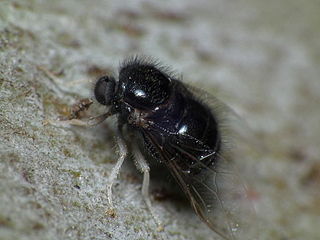
Acrocerinae is a subfamily of small-headed flies in the family Acroceridae. Their larvae are endoparasites of araneomorph spiders, with the exception of Carvalhoa appendiculata which can develop as ectoparasitoids on their host spiders. Traditionally, the subfamily included the genera now placed in Cyrtinae and Ogcodinae, but the subfamily in this sense was found to be polyphyletic and was split up in 2019.

Philopotinae is a subfamily of small-headed flies. They have an arched body shape, as well as enlarged postpronotal lobes that form a collar behind the head. Their larvae are endoparasites of araneomorph spiders in the subgroup Entelegynae.
Neophilopota is a genus of small-headed flies. It contains only a single species, Neophilopota brevirostris, described by Schlinger in 2013. It is endemic to Mexico.
Coquena is a genus of small-headed fly found in Argentina and Chile. It was first established by Evert I. Schlinger in 2013.
Pialea is a genus of small-headed flies. It is known from South America.

Acrocera is a genus of small-headed flies in the family Acroceridae.

Ogcodes is a genus of small-headed flies in the family Acroceridae. About 90 species have been described for the genus.
Eulonchus halli is a species of small-headed flies in the family Acroceridae. It was named after one of its original collectors, Jack C. Hall, who was also a colleague of the species's author, Evert I. Schlinger, at the University of California.

Eulonchus is a genus of small-headed flies in the family Acroceridae. There are six described species in Eulonchus. The genus is found in North America. Adults have a metallic blue, green or sometimes purple coloration, giving them a jewel-like appearance. A common name for flies in the genus is the North American jewelled spider flies. Adults are also known as "sapphires" or "emeralds".

Pterodontia is a genus of small-headed flies. There are at least 20 described species in Pterodontia.
Pterodontia flavipes is a species of small-headed flies. Adult males are 5.5–10.5 mm in size, while adult females are 5–9 mm. The larvae are thought to enter their host spiders at the leg articulations. First instar larvae of the species have also been recorded attacking the mites Podothrombium and Abrolophus.
Ocnaea is a genus of small-headed flies. There are 20 described species in Ocnaea.

Lasia is a genus of small-headed flies in the family Acroceridae. There are about 19 described species in Lasia, which are distributed in the New World.
Carvalhoa is a genus of small-headed flies in the family Acroceridae. The genus is endemic to Chile. It was originally known as Sphaerops, named by Rodolfo Amando Philippi in 1865. This name was found to be preoccupied by the reptile genus Sphaerops Gray, 1845, so it was renamed to Carvalhoa by Ahmet Ömer Koçak and Muhabbet Kemal in 2013. The genus is named after the Brazilian dipterist Claudio José Barros de Carvalho.
Philopota is a genus of small-headed flies in the family Acroceridae. It is the type genus of the subfamily Philopotinae.

Panops is a genus of small-headed flies. It is endemic to Australia and the Papua region of Indonesia. Males and females measure 8.0–12.5 mm and 9.5–14.5 mm, respectively.
Apsona is a genus of small-headed flies. It contains only one species, Apsona muscaria, which is endemic to New Zealand. It is very similar to the North American species Eulonchus smaragdinus.

Sabroskya is a genus of small-headed flies in the family Acroceridae. It is known from South Africa and Malawi. It is named after the American entomologist Curtis Williams Sabrosky.
Exetasis is a genus of small-headed flies. It is known from Brazil and Argentina.

Cyrtinae is a subfamily of the Acroceridae. Their larvae are endoparasites of araneomorph spiders in the subgroup Entelegynae.









